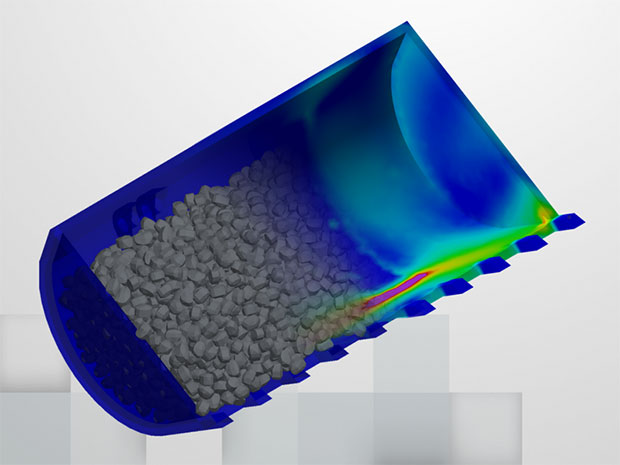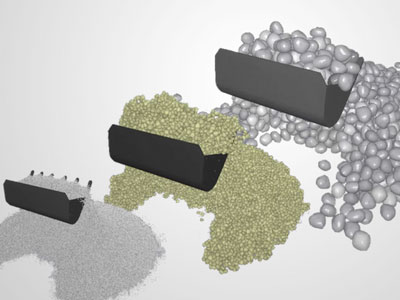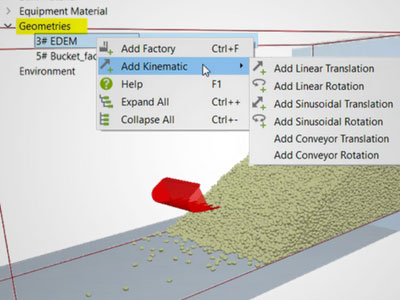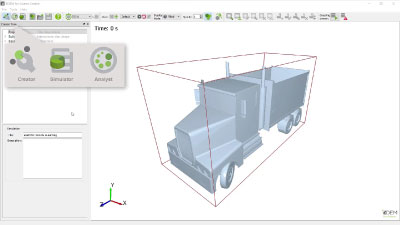Latest News
May 10, 2017
EDEM (DEM Solutions Ltd.) is in the process of introducing a line of discrete element method (DEM) software designed to make bulk material simulation accessible to all engineers who use finite element analysis (FEA) and multibody dynamics (MBD) software in the design of heavy equipment. Called “EDEM for CAE,” the new products integrate with leading FEA and MBD software tools and extend the host software with a bulk material simulation system. The first two products available in this new series are EDEM for ANSYS and EDEM for MSC Adams.
DEM is a particle-scale numerical method for modeling the bulk behavior of granular materials such as coal, rocks, particles, soils and ores. With DEM technology, engineers can simulate the behavior of materials of any size and shape as well as simulate how materials interact with machines and equipment.
 The EDEM for CAE discrete element method (DEM) software line brings bulk material simulations to engineers using major finite element analysis and multibody dynamics systems in the the design of heavy equipment. Image courtesy of EDEM.
The EDEM for CAE discrete element method (DEM) software line brings bulk material simulations to engineers using major finite element analysis and multibody dynamics systems in the the design of heavy equipment. Image courtesy of EDEM.EDEM for CAE eliminates the need for design engineers working in the construction, off-highway, mining and heavy industry sectors to use hand calculations and rely on assumptions to predict the effect of materials on their equipment, the company says. The software links with the host analysis system and provides engineers with a library of thousands of material models, representing a wide range of real materials. The database delivers information on the forces and material loads acting on equipment. All the DEM analyses are carried out in the familiar environment of the host software. EDEM for CAE does not require DEM expertise to use, according to the company.
 For realistic material loads, EDEM for CAE has a library of thousands of materials models representing ores, soils, rocks, gravels, particles and the like. Image courtesy of EDEM.
For realistic material loads, EDEM for CAE has a library of thousands of materials models representing ores, soils, rocks, gravels, particles and the like. Image courtesy of EDEM.EDEM for ANSYS enables engineers to add realistic bulk material loads as standard in ANSYS structural analyses. EDEM describes this simulation tool as easy to use, fully streamlined and integrated within the ANSYS Workbench environment. Users launch EDEM for ANSYS directly from the Workbench environment, where they set up an analysis, select the best material match for their application from the EDEM for CAE material library and run their bulk material simulation. Users can link the bulk material forces acting on equipment to other ANSYS analysis systems, such as static or transient structural, for use as an input boundary condition for an FEA simulation.
 Users launch EDEM for ANSYS from within ANSYS Workbench. All analyses are performed in ANSYS. Neither knowledge of discrete element method (DEM) nor expertise in bulk material simulation are required. Image courtesy of EDEM.
Users launch EDEM for ANSYS from within ANSYS Workbench. All analyses are performed in ANSYS. Neither knowledge of discrete element method (DEM) nor expertise in bulk material simulation are required. Image courtesy of EDEM.On its website the company describes EDEM for Adams as a standalone application that connects to MSC Adams multibody dynamics simulation environment using the Adams Co-Simulation Interface (ACSI). The company explains that, during simulation, the coupling transfers the realistic material loads from EDEM for Adams directly into MSC Adams. There, they are used to calculate the effect on equipment dynamics. The updated dynamics then pass back to EDEM to provide realistic force-feedback.
 With EDEM for Adams discrete element method (DEM) analyses are performed in the MSC Adams multibody dynamics simulation environment directly. Image courtesy of EDEM.
With EDEM for Adams discrete element method (DEM) analyses are performed in the MSC Adams multibody dynamics simulation environment directly. Image courtesy of EDEM.“We are taking co-simulation to the next level by enabling engineers with no DEM knowledge to benefit from the key insights that this technology brings,” Richard LaRoche, chief executive officer of EDEM, said in a press statement. “Our ultimate goal is to fully democratize DEM so it is available to all engineers, not just the experts.”
In addition to EDEM for ANSYS and EDEM for Adams, the company says that future plans call for EDEM for LMS Virtual.Lab Motion from Siemens as well as other FEA and MBD analysis systems yet to be announced. For more information on the EDEM for CAE software series, click here to access a dedicated web page.
Go here for more on EDEM for ANSYS.
Go here for more on EDEM for Adams.
Download the ebook “Optimizing Heavy Equipment Design for Handling Bulk Materials.”
See why DE‘s Editors selected EDEM for CAE as their Pick of the Week.
Sources: Press materials received from the company and additional information gleaned from the company’s website.
Subscribe to our FREE magazine, FREE email newsletters or both!
Latest News
About the Author
Anthony J. Lockwood is Digital Engineering’s founding editor. He is now retired. Contact him via [email protected].
Follow DE





